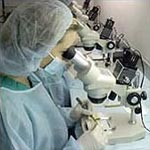Hey Doc, generally speaking where does the donar site begin and how much donor hair do I have. It obviously ends in the back of the neck. But where at the back of the head does it start, speacially if your a early norwood recipient.

This answer is going to be a little long and technical, but hopefully some find interest in this…
Donor Area:
 The donor area is always the rim of hair that is seen in the Norwood Class 7 patient (see art at right). It starts at the occipital prominence of the skull (back of the skull) and goes up in the midline to a height of about 2 1/2 inches. It runs from the temple prominences by the forehead from one side to the other. The total measurement depends upon the size of the head. Large heads might have a 15 inch measurement from temple prominence to temple prominence and let’s say 13 inches to be safe, of which 1/2 inch on each side is not usable because any hair extraction from that close to the forehead will show as a thin donor area or a scar from the frontal view. So if you were to harvest the donor area (either by strip or FUE) the donor area would measure 12 inches long multiplied by 2.5 inches high or 30 square inches of scalp in a person with a typical size head. Half of that 30 square inch number would produce 15 square inches of usable donor hair. Each square inch in a Caucasian’s scalp with average hair density contains 1250 hairs which if multiplied times 15 square inches (half the donor area) would give 18,750 permanent movable hairs or in theory 9,375 two hair follicular units (grafts). I know this estimate is high, because the side rim of the donor area usually has a lower donor density than hair in the main part of the scalp.
The donor area is always the rim of hair that is seen in the Norwood Class 7 patient (see art at right). It starts at the occipital prominence of the skull (back of the skull) and goes up in the midline to a height of about 2 1/2 inches. It runs from the temple prominences by the forehead from one side to the other. The total measurement depends upon the size of the head. Large heads might have a 15 inch measurement from temple prominence to temple prominence and let’s say 13 inches to be safe, of which 1/2 inch on each side is not usable because any hair extraction from that close to the forehead will show as a thin donor area or a scar from the frontal view. So if you were to harvest the donor area (either by strip or FUE) the donor area would measure 12 inches long multiplied by 2.5 inches high or 30 square inches of scalp in a person with a typical size head. Half of that 30 square inch number would produce 15 square inches of usable donor hair. Each square inch in a Caucasian’s scalp with average hair density contains 1250 hairs which if multiplied times 15 square inches (half the donor area) would give 18,750 permanent movable hairs or in theory 9,375 two hair follicular units (grafts). I know this estimate is high, because the side rim of the donor area usually has a lower donor density than hair in the main part of the scalp.
Density:
We must really talk about the amount of hair that must be left behind after harvesting not the hair we are going to take out. In the average Caucasian with average hair density, both residual and donor hair amounts are equal so that we will not be able to ‘see through’ the remaining donor area after the maximum number of transplants are taken; however, the lower the donor density, keeping the 18,750 hairs in place (to prevent a see-through look) causes the surgeon a problem and in removing the donor strip, the remaining donor skin will almost certainly stretch, reducing the remaining density.
Hair Character:
When a typical Asian patient comes for a hair transplant, the removable hair is substantially reduced (it will leave behind 80% of 18,750 hairs or 15,000 hairs). Let’s go through the calculations again for a typical Asian patient with 20% less donor density than a Caucasian. The Asian patient would have 15 square inches of usable donor hair and 15,000 remain after the donor strip is harvested. The total supply of the donor area for the hypothetical Asian would be 15,000 hairs or 7,500 grafts. If we then go to a person of African heritage, that number reduces even further (densities in the African can average as low as 60% of a Caucasian’s density). The removable donor area will yield 11,250 hairs or 5,625 grafts. As the donor area is harvested, it will stretch, reducing the remaining density substantially for future procedures.
It should be evident to the reader, that the size of the bald area is a critical determinant (need vs availability), a conundrum of clear proportion as the real donor hair availability becomes apparent. The quality of the hair (thin vs thick) the character of the hair (straight vs wavy or kinky) and the color of the hair and skin (donor contrast between hair and skin color) must play a significant role in the art of the hair transplant and where to put what hair is available. Make no mistake, this is an art form.
Keeping Some Doctors Honest:
By the above calculations, the Asian patient or the African patient has substantially less hair that can be used for hair transplantation. These calculations assume that the looseness of the scalp is not a variable (of course this is not really true) and that scarring is not a problem (everyone scars to some degree and those that scar worse are in a difficult situation for taking larger number of grafts).
Maybe you will understand better why I get so angry when doctors say that they can transplant numbers of grafts that are in the stratosphere. Some of the recommendations I hear smell of dishonesty or a naivety of the doctor to the basic mathematics of the hair transplantation process.







 “Thinning hair” means a person is losing hair (usually hair that is miniaturized – i.e. thinning of the hair shaft) and does not have as much hair bulk as they once had. “Miniaturization” of hair means that a person’s hair shaft is not as thick in one area when compared to another area as it should be in its normal/healthy state. It is normal to have around 10% of miniaturized hairs for people who are not balding that may reflect what we call vellus hairs, present in every follicular unit.
“Thinning hair” means a person is losing hair (usually hair that is miniaturized – i.e. thinning of the hair shaft) and does not have as much hair bulk as they once had. “Miniaturization” of hair means that a person’s hair shaft is not as thick in one area when compared to another area as it should be in its normal/healthy state. It is normal to have around 10% of miniaturized hairs for people who are not balding that may reflect what we call vellus hairs, present in every follicular unit.  I would love to mention the doctors’ names, but that would almost certainly bring me into court, something that I do not wish to spend my life doing (it might bring me to the brink of financial ruin with large lawyer fees just to prove what I said). I get angry when I see the mess created by many of these doctors, but alas, you must use the information in ways to become a knowledgeable buyer, so I use this blog to call people’s attention to what they need to look for when engaging a doctor’s service for a hair transplant.
I would love to mention the doctors’ names, but that would almost certainly bring me into court, something that I do not wish to spend my life doing (it might bring me to the brink of financial ruin with large lawyer fees just to prove what I said). I get angry when I see the mess created by many of these doctors, but alas, you must use the information in ways to become a knowledgeable buyer, so I use this blog to call people’s attention to what they need to look for when engaging a doctor’s service for a hair transplant. At the
At the 
 Thanks for your kind words. My military experience was long ago, but rewarding. I could write a book just about my experiences, but this isn’t really the place for that right now. I would like to thank you for your service and wish you the best of luck.
Thanks for your kind words. My military experience was long ago, but rewarding. I could write a book just about my experiences, but this isn’t really the place for that right now. I would like to thank you for your service and wish you the best of luck. The International Society of Hair Restoration Surgery (ISHRS) has information about fellowship programs for physicians
The International Society of Hair Restoration Surgery (ISHRS) has information about fellowship programs for physicians